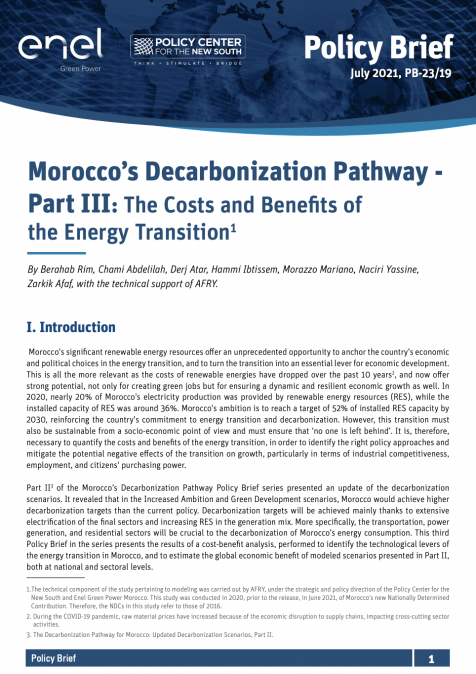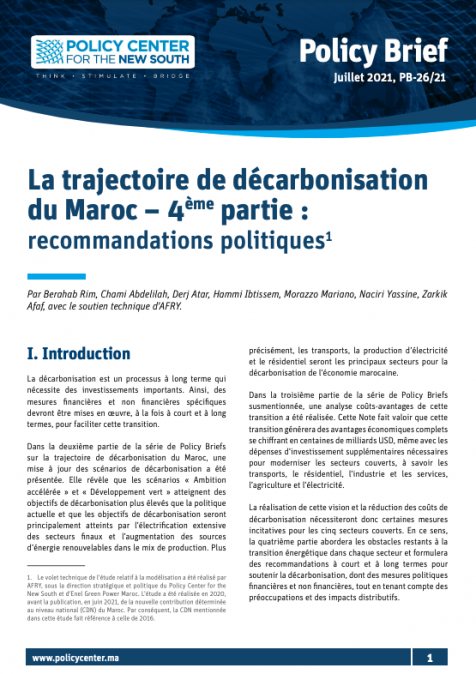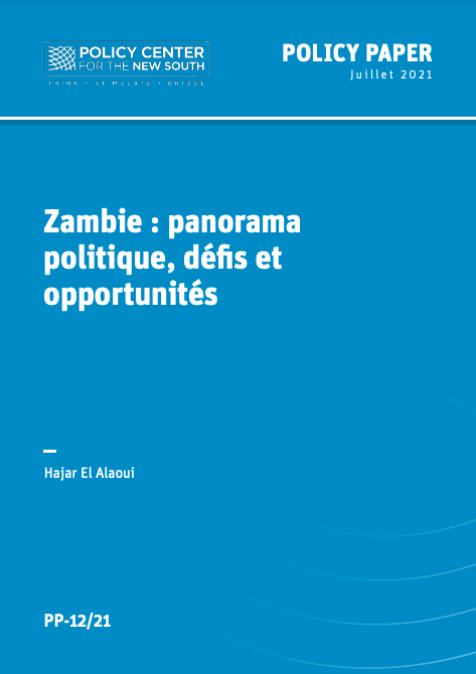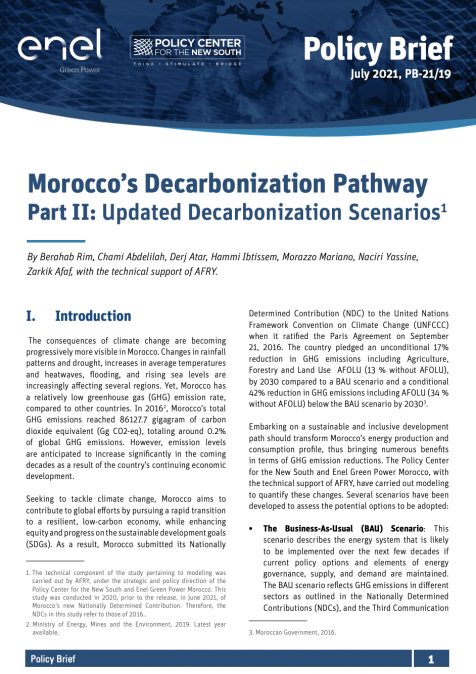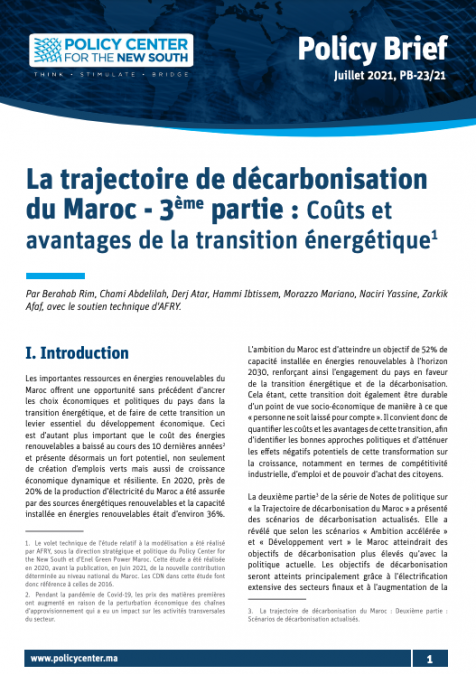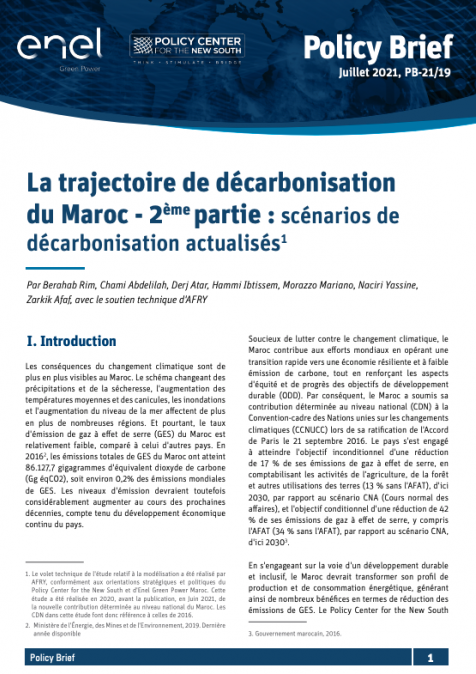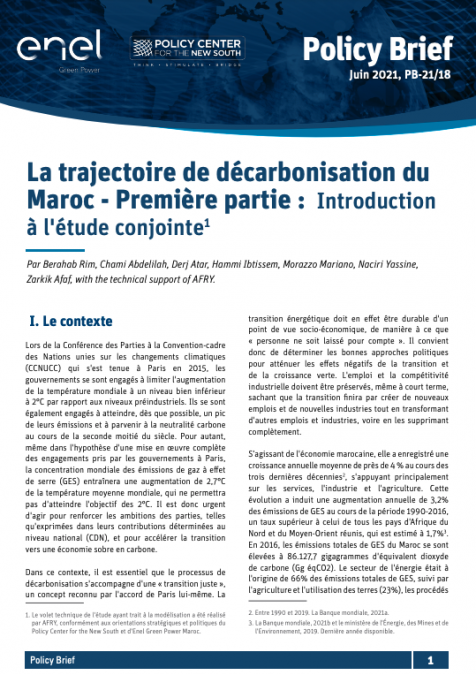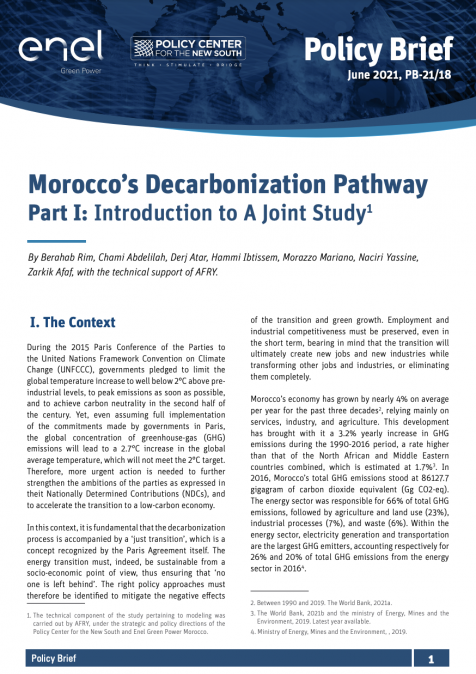This episode focuses on the Africa Pulse Report 2025, the World Bank’s flagship analysis of economic trends and policy challenges in Sub-Saharan Africa. As the region works to strengthen its recovery while contending with structural and macroeconomic difficulties, Andrew Dabalen, Chief Economist for the Africa Region at the World Bank, shares key insights and takeaways from this year’s edition.
RELATED CONTENT
-
AuthorsChami AbdelilahDerj AtarHammi IbtissemMorazzo MarianoNaciri Yassinewith the technical support of AFRYJuly 29, 2021As decarbonization is a long-term process and requires significant investments, specific financial and non- financial measures will need to be implemented, both in the short and long term, to facilitate this transition. In Part II of Morocco’s decarbonization pathway Policy Brief series, an update of the decarbonization scenarios was presented. It revealed that the Increased Ambition and Green Development scenarios achieve higher decarbonization targets than current policy. It showe ...
-
AuthorsChami AbdelilahDerj AtarHammi IbtissemMorazzo MarianoNaciri Yassinewith the technical support of AFRYJuly 23, 2021La décarbonisation est un processus à long terme qui nécessite des investissements importants. Ainsi, des mesures financières et non financières spécifiques devront être mises en œuvre, à la fois à court et à long termes, pour faciliter cette transition. Dans la deuxième partie de la série de Policy Briefs sur la trajectoire de décarbonisation du Maroc, une mise à jour des scénarios de décarbonisation a été présentée. Elle révèle que les scénarios « Ambition accélérée » et « Dévelop ...
-
AuthorsChami AbdelilahDerj AtarHammi IbtissemMorazzo MarianoNaciri Yassinewith the technical support of AFRYJuly 19, 2021Morocco's significant renewable energy resources offer an unprecedented opportunity to anchor the country’s economic and political choices in the energy transition, and to turn the transition into an essential lever for economic development. This is all the more relevant as the costs of renewable energies have dropped over the past 10 years2, and now offer strong potential, not only for creating green jobs but for ensuring a dynamic and resilient economic growth as well. In 2020, ne ...
-
 AuthorsJuly 16, 2021The BDA Currents: Where Diplomacy Meets Business, is the Brussels Diplomatic Academy’s annual report covering the wider geopolitical and other factors influencing and affecting the world of diplomacy, international relations and global business. The journal focuses on issues of topical interest around the centers of global power, influence and importance, including the continents of Europe and Africa, the Middle East, China, India & Asia, Russia and the Commonwealth of Independe ...
AuthorsJuly 16, 2021The BDA Currents: Where Diplomacy Meets Business, is the Brussels Diplomatic Academy’s annual report covering the wider geopolitical and other factors influencing and affecting the world of diplomacy, international relations and global business. The journal focuses on issues of topical interest around the centers of global power, influence and importance, including the continents of Europe and Africa, the Middle East, China, India & Asia, Russia and the Commonwealth of Independe ... -
AuthorsJuly 12, 2021Frappée de plein fouet par la crise sanitaire de la Covid-19, la République de Zambie, déjà fragilisée, fait face à de nombreux défis sur les plans politique, économique, social et climatique. Outre sa position géographique de pays enclavé, le croissant de l’Afrique australe se positionne comme l’une des premières victimes du réchauffement climatique sur le continent rendant vulnérable une partie de sa population souffrant d’insécurité alimentaire accrue. Par ailleurs, et à l’approc ...
-
AuthorsChami AbdelilahDerj AtarHammi IbtissemMorazzo MarianoNaciri Yassinewith the technical support of AFRYJuly 9, 2021The consequences of climate change are becoming progressively more visible in Morocco. Changes in rainfall patterns and drought, increases in average temperatures and heatwaves, flooding, and rising sea levels are increasingly affecting several regions. Yet, Morocco has a relatively low greenhouse gas (GHG) emission rate, compared to other countries. In 20162, Morocco’s total GHG emissions reached 86127.7 gigagram of carbon dioxide equivalent (Gg CO2-eq), totaling around 0.2% of glo ...
-
AuthorsChami AbdelilahDerj AtarHammi IbtissemMorazzo MarianoNaciri Yassinewith the technical support of AFRYJuly 9, 2021Les importantes ressources en énergies renouvelables du Maroc offrent une opportunité sans précédent d’ancrer les choix économiques et politiques du pays dans la transition énergétique, et de faire de cette transition un levier essentiel du développement économique. Ceci est d’autant plus important que le coût des énergies renouvelables a baissé au cours des 10 dernières années2 et présente désormais un fort potentiel, non seulement de création d’emplois verts mais aussi de croissan ...
-
AuthorsChami AbdelilahDerj AtarHammi IbtissemMorazzo MarianoNaciri Yassinewith the technical support of AFRYJuly 9, 2021Les conséquences du changement climatique sont de plus en plus visibles au Maroc. Le schéma changeant des précipitations et de la sécheresse, l'augmentation des températures moyennes et des canicules, les inondations et l'augmentation du niveau de la mer affectent de plus en plus de nombreuses régions. Et pourtant, le taux d'émission de gaz à effet de serre (GES) du Maroc est relativement faible, comparé à celui d'autres pays. En 20162, les émissions totales de GES du Maroc ont atte ...
-
AuthorsChami AbdelilahDerj AtarHammi IbtissemMorazzo MarianoNaciri Yassinewith the technical support of AFRYJune 28, 2021Lors de la Conférence des Parties à la Convention-cadre des Nations unies sur les changements climatiques (CCNUCC) qui s'est tenue à Paris en 2015, les gouvernements se sont engagés à limiter l'augmentation de la température mondiale à un niveau bien inférieur à 2°C par rapport aux niveaux préindustriels. Ils se sont également engagés à atteindre, dès que possible, un pic de leurs émissions et à parvenir à la neutralité carbone au cours de la seconde moitié du siècle. Pour autant, m ...
-
AuthorsChami AbdelilahDerj AtarHammi IbtissemMorazzo MarianoNaciri Yassinewith the technical support of AFRYJune 28, 2021During the 2015 Paris Conference of the Parties to the United Nations Framework Convention on Climate Change (UNFCCC), governments pledged to limit the global temperature increase to well below 2°C above pre- industrial levels, to peak emissions as soon as possible, and to achieve carbon neutrality in the second half of the century. Yet, even assuming full implementation of the commitments made by governments in Paris, the global concentration of greenhouse-gas (GHG) emissions will ...

